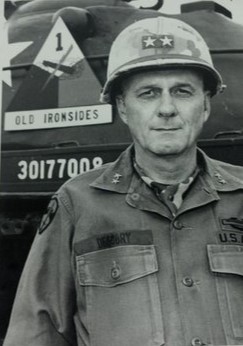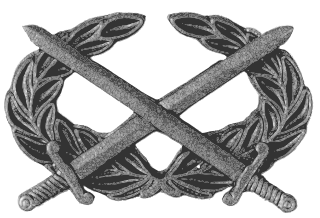
The Bronze Star Medal (BSM) is a United States Armed Forces decoration awarded to members of the United States Armed Forces for either heroic achievement, heroic service, meritorious achievement, or meritorious service in a combat zone.

Lieutenant General John Randolph Vines is the former commander of the U.S. Army's XVIII Airborne Corps and Multi-National Corps – Iraq.
The Combat Action Ribbon, is a high precedence United States Navy, United States Coast Guard, and United States Marine Corps military decoration awarded to United States sea service members "who have actively participated in ground or surface combat."

A marksman is a person who is skilled in precision shooting. In modern military usage this typically refers to the use of projectile weapons such as an accurized scoped long gun such as designated marksman rifle or a sniper rifle) to shoot at high-value targets at longer-than-usual ranges.

The Combat Infantryman Badge (CIB) is a United States Army military decoration. The badge is awarded to infantrymen and Special Forces soldiers in the rank of colonel and below, who fought in active ground combat while assigned as members of either an Infantry or Special Forces unit of brigade size or smaller at any time after 6 December 1941. For those soldiers who are not members of an infantry, or Special Forces unit, the Combat Action Badge (CAB) is awarded instead. For soldiers with an MOS in the medical field they would, with the exception of a Special Forces Medical Sergeant (18D), receive the Combat Medical Badge. 18D Special Forces Medics would receive the Combat Infantryman badge instead.
The Expert Infantryman Badge, or EIB, is a special skills badge of the United States Army.
A "V" device is a metal 1⁄4-inch (6.4 mm) capital letter "V" with serifs which, when worn on certain decorations awarded by the United States Armed Forces, distinguishes an award for heroism or valor in combat instead of for meritorious service or achievement.

A parachutist badge is a military badge awarded by the armed forces of many states to soldiers who have received parachute training and completed the required number of jumps. It is difficult to assess which country was the first to introduce such an award.

The Parachutist Badge, also commonly referred to as "Jump Wings" is a military badge of the United States Armed Forces. The United States Space Force and United States Coast Guard are the only branches that do not award the Parachutist Badge, but their members are authorized to receive the Parachutist Badges of other services in accordance with their prescribed requirements. The DoD military services are all awarded the same Military Parachutist Badge. The U.S. Army and U.S. Air Force issue the same Senior and Master Parachutist Badges while the U.S. Navy and U.S. Marine Corps issue the Navy and Marine Corps Parachutist Badge to advanced parachutists. The majority of the services earn their Military Parachutist Badge through the U.S. Army Airborne School.

The Indonesian Army is the land branch of the Indonesian National Armed Forces. It has an estimated strength of 300,000 active personnel. The history of the Indonesian Army has its roots in 1945 when the Tentara Keamanan Rakyat (TKR) "People's Security Forces" first emerged as a paramilitary and police corps.

The Combat Action Badge (CAB) is a United States military award given to soldiers of the U.S. Army of any rank and who are not members of an infantry or special forces MOS, for being "present and actively engaging or being engaged by the enemy, and performing satisfactorily in accordance with prescribed rules of engagement" at any point in time after 18 September 2001.

Shoulder sleeve insignia (SSI) are distinctive cloth patches worn on the left sleeve of the United States Army uniform just below the shoulder seam by soldiers assigned to divisions, corps, armies, and other specifically authorized organizations. The are also worn on the right sleeve by soldiers to indicate former overseas service with certain units during periods of U.S. military operations in hostile conditions (MOHC).

Unofficial badges of the United States military are those badges or emblems that do not appear in United States military regulations but that many individuals serving in the United States military wear or display. Unofficial badges may also be bestowed for a one time action or be authorized under the authority of a local commander.

The maroon beret in a military configuration has been an international symbol of airborne forces since the Second World War. It was first officially introduced by the British Army in 1942, at the direction of Major-General Frederick "Boy" Browning, commander of the British 1st Airborne Division. It was first worn by the Parachute Regiment in action in North Africa during November 1942.

Stephen M. Twitty is a retired lieutenant general in the United States Army. Twitty assumed command of First United States Army on July 15, 2016, relinquishing command to become deputy commander of United States European Command on 9 August 2018. Previously, he was commanding general of Fort Bliss and the 1st Armored Division. Twitty was awarded the Silver Star during Operation Iraqi Freedom. Noted for his relationship with journalist David Bloom, who was embedded with his battalion during the invasion of Iraq in 2003, Twitty has served in five combat deployments, including tours in the Gulf War, Afghanistan, Iraq, and Kuwait. He has commanded at the company, battalion, and brigade level during the wars in Iraq and Afghanistan. Twitty is a graduate of South Carolina State University and a member of the Omega Psi Phi fraternity. He was inducted into the South Carolina State University ROTC Hall of Fame in 2009, and selected as one of the university's Distinguished Alumni in 2004.

James C. Yarbrough is a retired brigadier general in the United States Army.

Leo J. Meyer was a soldier in the United States Army, one of only three hundred and twenty-four men who have been awarded three Combat Infantryman Badges out of more than the twenty-three million men who served in the US Army between December 1941 and December 2007. Colonel Meyer was inducted into the U.S. Army Officer Candidate School Hall of Fame in 2009.

Troops began wearing berets as a part of the headgear of military uniforms in some European countries during the 19th century; since the mid-20th century, they have become a component of the uniforms of many armed forces throughout the world. Military berets are usually pushed to the right to free the shoulder that bears the rifle on most soldiers, but the armies of some countries, mostly within Europe, South America, and Asia, have influenced the push to the left.

William Robertson Desobry was a senior U.S. Army field commander in Germany during the Cold War, and a Lieutenant General in the United States Army. General Desobry was a decorated hero from World War II, and played a significant role as an advisor to the Republic of Vietnam Army and on the Army Staff during the Vietnam War. In addition to commanding a division and corps, he was the Commanding General of the Armor Center and was the President of the Tank Task Force, which led to the creation of the M1 Abrams.

The Army Combat Badge (ACB) is a military decoration that is awarded to any member of the Australian Defence Force (ADF) for service with an Army combat element in warlike operations. Its equivalent is the Infantry Combat Badge.
















